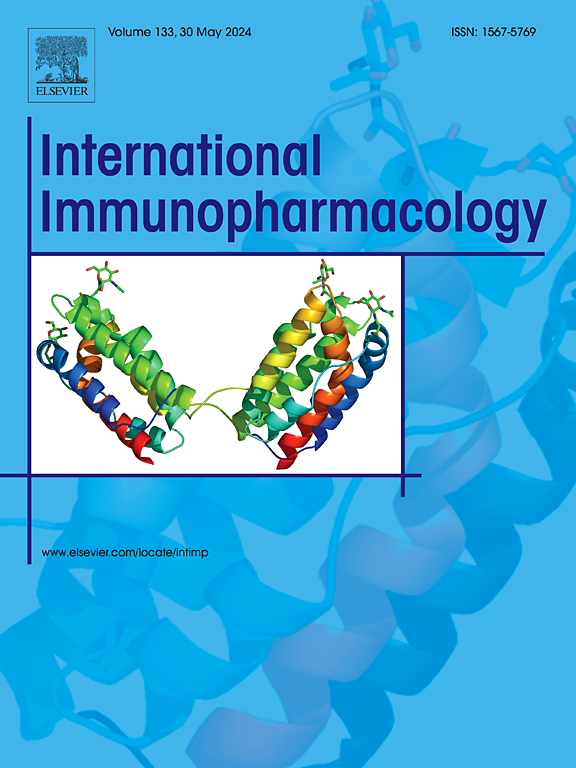Melatonin alleviates retinal injury induced by vigabatrin and partially enhances its antiepileptic effects
IF 4.8
2区 医学
Q2 IMMUNOLOGY
引用次数: 0
Abstract
Structural optimization and combinational use with additive agents might help expand the clinical use of vigabatrin (VGB). Aiming to investigate the combinational effect of melatonin (MLT) on the antiepileptic action and retinal damage of VGB, a rat epilepsy model was induced by intraperitoneal injection of kainic acid (KA) and evaluated via both Racine grading and electroencephalogram (EEG). MLT (5, 10, 20 mg/kg) and VGB (50, 150 mg/kg) were administered intragastrically for 4 weeks, alone or together. The behavioral performance was measured during the remission of seizures via a series of tasks including the open field test (OFT), beam walking test (BW), Y-maze, and novel object recognition test (NOR). The morphological changes of the hippocampus and retina were observed using HE, Nissl, or immunofluorescence staining. Furthermore, the expression of proteins associated with synaptic plasticity and the Wnt/β-catenin/GSK3β signaling pathway were assessed. The results showed that intraperitoneal injection of KA could induce not only seizure, but also long-term behavioral impairments of sense, motion, and learning and memory in rats. Moreover, VGB could alleviate the neuroinflammation and balance the expression of synaptic plasticity and Wnt/β-catenin/GSK3β pathway proteins of epileptic rats. A combination of MLT couldn't enhance the effect of VGB in prolonging the seizure latency but presented an additive effect in alleviating the seizures grading V and improving the behavioral performance in the BW. Crucially, the combination of MLT considerably reduced the retinal cell damage caused by VGB. These results suggested that MLT could be a beneficial combination for VGB in the treatment of epilepsy, which might provide fresh insight into the clinical application of VGB and MLT.
求助全文
约1分钟内获得全文
求助全文
来源期刊
CiteScore
8.40
自引率
3.60%
发文量
935
审稿时长
53 days
期刊介绍:
International Immunopharmacology is the primary vehicle for the publication of original research papers pertinent to the overlapping areas of immunology, pharmacology, cytokine biology, immunotherapy, immunopathology and immunotoxicology. Review articles that encompass these subjects are also welcome.
The subject material appropriate for submission includes:
• Clinical studies employing immunotherapy of any type including the use of: bacterial and chemical agents; thymic hormones, interferon, lymphokines, etc., in transplantation and diseases such as cancer, immunodeficiency, chronic infection and allergic, inflammatory or autoimmune disorders.
• Studies on the mechanisms of action of these agents for specific parameters of immune competence as well as the overall clinical state.
• Pre-clinical animal studies and in vitro studies on mechanisms of action with immunopotentiators, immunomodulators, immunoadjuvants and other pharmacological agents active on cells participating in immune or allergic responses.
• Pharmacological compounds, microbial products and toxicological agents that affect the lymphoid system, and their mechanisms of action.
• Agents that activate genes or modify transcription and translation within the immune response.
• Substances activated, generated, or released through immunologic or related pathways that are pharmacologically active.
• Production, function and regulation of cytokines and their receptors.
• Classical pharmacological studies on the effects of chemokines and bioactive factors released during immunological reactions.

 求助内容:
求助内容: 应助结果提醒方式:
应助结果提醒方式:


